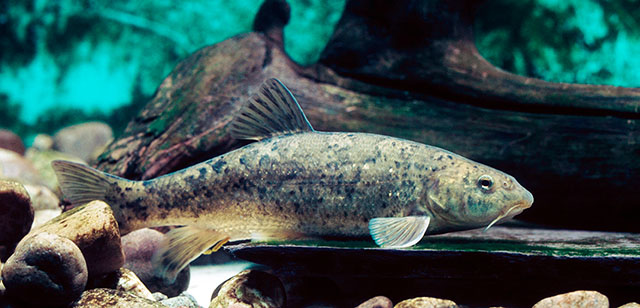| Cyprinidae (Minnows or carps), subfamily: Barbinae |
| 27 cm SL (male/unsexed); 25.3 cm FL (female); max.weight: 200.0 g |
|
benthopelagic; freshwater |
| Europe: rivers draining to Mediterranean from Besos (near Barcelona, northeastern Spain) to Var (at Nice, southeastern France) drainages, including Rhône as far uprivers as Lyon; some headwaters of Garonne basin in Ariège, Tarn and Aveyron (France), apparently native in most, but introduced in at least some upper Tarn localities (Ref. 59043). Barbus meridionalis graellsii found in southern France and central and northern Spain (now recognized as species (Ref. 13696)). The Italian populations now recognized as Barbus caninus (Ref. 13696). |
|
Dorsal spines (total): 3-4; Dorsal soft rays (total): 7-9; Anal spines: 2-3; Anal soft rays: 5-6; Vertebrae: 34-35. Diagnosed from other species of Barbus and Luciobarbus in Apennine and Iberian Peninsulas and southern France by the following characters: 44-48 +2 scales on lateral line; 24-28 scale rows around caudal peduncle; head, back, sides and fins with large, irregular black dots; last simple dorsal ray not spinous, flexible, not serrated posteriorly; lower lip thick, with a median swollen pad (Ref. 59043). Caudal fin with 16-19 rays (Ref. 2196). |
| Inhabits upper and middle stretches of streams with fast, clear and well oxygenated water, as well as lowland areas where Barbus barbus is absent (Ref. 59043). A short-lived species which is found in clear waters over sand and gravel. Feeds on small invertebrates and (rarely) plants. A combative fish which can be captured with bows or floating ling lines (Ref. 30578). Threatened due to water abstraction and pollution (Ref. 26100) and habitat modification (Ref. 59043). In southern France, locally forms partly fertile hybrids with B. barbus. Attains a maximum size of about 27 cm SL (Ref. 59043). |
|
Near Threatened (NT); Date assessed: 31 January 2006 Ref. (130435)
|
| harmless |
Source and more info: www.fishbase.org. For personal, classroom, and other internal use only. Not for publication.
